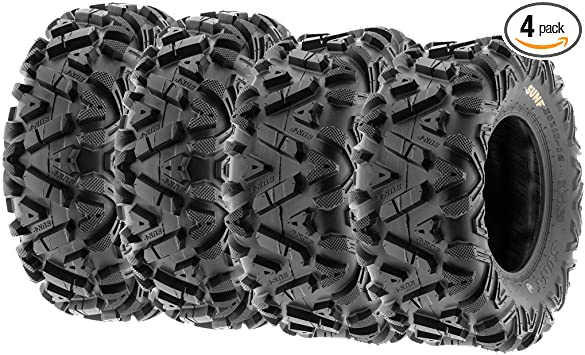Whether you’re in the market for rocky terrain ATV tires or in search of something that allows you to reach top speeds, making the proper selection is a must. Choosing the right type of tires ensures a safe and productive ride, and also prevents you from becoming stuck in problematic terrain created by muddy conditions.
While every ATV rider is unique in their preferences, there are a few general rules you can follow to help make the best decision. Here are a few things to keep in mind when shopping for new ATV tires.
How Much Is a Full Set of ATV Tires?
Costs for ATV racing tires and other types vary according to a number of factors. For instance, the size of the tires you choose can make a huge difference in cost. Larger tires are naturally going to cost more because more materials are needed to construct them.
The style of the tire you purchase also makes a difference when it comes to expense. All-terrain tires are the least expensive because of their standard design. However, they’re not suitable for all applications, especially when traversing tough terrain.
In this case, you might need more expensive mud or rock-crawling tires to ensure top performance. In general, anything that’s more complicated to construct or requires more material will increase the expense.
How Do You Mount an ATV Tire?
Once you’ve decided between all-terrain and ATV sand tires, the next step is mounting the tire onto your vehicle. While you can have mounting professionally performed, doing it yourself saves some money. Fortunately, the task is relatively easy when you know the right steps:
- Remove the wheel and deflate the current tire
- Break the bead seal on the current tire and remove the tire from the rim
- Clean the lip of the rim and apply new bed sealer for a firm hold
- Lubricate the tire bead in preparation for the new tire
- Mount the new tire onto the rim
- Inflate the new tire
You’ll need some tools to properly mount the new ATV tire onto the wheel. This includes valve stem tools, tire spoons, lubricant, and an air compressor.
How Can You Keep ATV Tires in Good Shape?
After your new tire is mounted, you naturally want to keep it in good working condition for as long as possible. While these tires are designed to be rugged and durable, there are still things you must do to reduce wear. Properly balancing tires ensures they receive a uniform amount of wear. You should also have tires re-balanced every 5,000 miles or so.
Maintaining sufficient air pressure is equally important. Check your PSI before every ride and refill if necessary according to the manufacturer’s specifications. Underinflated tires have a greater chance of damaged side walls, which can result in an expensive replacement well before it would normally be due.
If you routinely leave your ATV outside when not riding, it’s best to cover it. Sun exposure will wear down tires at an accelerated rate, not matter how good you are about caring for them. Covering your ATV will also preserve its paint job.
By taking the above steps, you can get the maximum enjoyment out of your vehicle. You can also reduce the chance of expensive repairs by keeping equipment in good shape.

